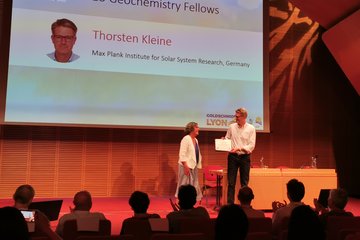Alle Typen
281.
Buchkapitel
Dawn-Dusk Asymmetries in Jupiter's Magnetosphere. In: Dawn-Dusk Asymmetries in Planetary Plasma Environments, S. 309 - 322 (Hg. Haaland, S.; Runov, A.; Forsyth, C.). Wiley, Hoboken (2017)
282.
Buchkapitel
12 - Energetic-particle environments in the solar system. In: Heliophysics, Active Stars, their Astrospheres, and Impacts on Planetary Environments, S. 270 - 288 (Hg. Schrijver, C. J.; Bagenal, F.; Sojka, J. J.). Cambridge University Press, Cambridge, United Kingdom (2016)
283.
Buchkapitel
15 - Energetic Particles and Waves in the Outer Planet Radiation Belts. In: Waves, Particles, And Storms in Geospace, S. 377 - 410 (Hg. Balasis, G.; Daglis, I. A.; Mann, I. R.). Oxford University Press, Oxford, United Kingdom (2016)
284.
Buchkapitel
Jupiter's Magnetotail. In: Magnetotails in the Solar System, Bd. 207, S. 85 - 98 (Hg. A. Keiling, C. M. J.; Delamere, P. A.). John Wiley Sons, Hoboken, NJ, USA (2015)
285.
Buchkapitel
Injection, Interchange, and Reconnection. In: Magnetotails in the Solar System, Bd. 207, S. 327 - 343 (Hg. A. Keiling, C. M. J.; Delamere, P. A.). John Wiley Sons, Hoboken, NJ, USA (2015)
286.
Buchkapitel
8.4.2 - Ionospheric science and space weather. In: Pathway to the Square Kilometre Array - The German White Paper, S. 101 - 102 (Hg. Klöckler, H. R.; Kramer, M.; Falcke, H.; Schwarz, D.; Eckart, A. et al.). MPI für Radioastronomie, Bonn, Germany (2012)
287.
Buchkapitel
Die Geschwister der Erde. In: Aus den Elfenbeintürmen der Wissenschaft, S. 151 - 164 (Hg. Neher, E.-M.). Wallstein Verlag, Göttingen (2011)
288.
Buchkapitel
Saturn's Magnetospheric Configuration. In: Saturn from Cassini-Huygens, S. 203 - 255 (Hg. Dougherty, M. K.; Esposito, L. W.; Krimigis, S. M.). Springer, Berlin (2009)
289.
Buchkapitel
24 - The configuration of Jupiter's magnetosphere. In: Jupiter: The Planet, Satellites and Magnetosphere, S. 593 - 616 (Hg. Bagenal, F.; Dowling, T.; McKinnon, W.). Cambridge University Press (2004)
290.
Buchkapitel
25 - The Dynamics of the Jovian magnetosphere. In: Jupiter: The Planet, Satellites and Magnetosphere, S. 617 - 638 (Hg. Bagenal, F.; Dowling, T.; McKinnon, W.). Cambridge University Press (2004)
291.
Buchkapitel
Die Galileo Mission, neue Erkenntnisse über planetare Magnetosphären. In: Max-Planck-Gesellschaft Jahrbuch 2000, S. 423 - 433 (Hg. der Max-Planck-Gesellschaft München, G.). Verlag Vandenhoeck & Rupprecht, Göttingen (2000)
292.
Buchkapitel
Ulysses in hohen heliographischen Breiten: Eine Übersicht über die mit am MPAe entwickelten Messinstrumenten erzielten Ergebnisse. In: Max-Planck-Gesellschaft Jahrbuch, S. 336. Max-Planck-Gesellschaft, München (1995)
293.
Konferenzbeitrag
A ground calibration facility for ion and electron spectrometers on the bepicolombo and juice missions. In: Proceedings of the International Astronautical Congress, IAC, Bd. 2018-October. (2018)
294.
Konferenzbeitrag
Charged particle measurements in the Saturnian magnetosphere during the Cassini Era 2004-2017. In: Serendipities in the solar system and beyond: proceedings of a symposium celebrating prof. Wing-Huen Ips 70th birthday held at National Central University, Taiwan, 10-13 July 2017, S. 163 (Hg. Ko, C.-M.; Yu, P.-C.; Chang, C.-K.). Astronomical Society of the Pacific, San Francisco (2018)
295.
Konferenzbeitrag
Measuring the magnetic vector with the He I 10830 Å line: A rich new world. In: Solar Polarization 4, S. 431 - 436 (Hg. Casini, R.; Lites, B. W.). (2006)
296.
Konferenzbeitrag
Tracing the Origins of the Solar System. In: Proceedings of the 39th ESLAB Symposium "Trends in Space Science and Cosmic Vision 2020". 39th ESLAB Symposium "Trends in Space Science and Cosmic Vision 2020", Noordwijk, 19. April 2005 - 21. April 2005. (2005)
297.
Konferenzbeitrag
Overview of Results from the Cassini Magnetospheric Imaging Instrument (MIMI) During the First Year of Operations. In: 36th Annual Lunar and Planetary Science Conference, S. 1361. (2005)
298.
Konferenzbeitrag
Bidirectional proton flows and comparison of freezing-in temperatures in ICMEs and magnetic clouds. In: Coronal and Stellar Mass Ejections, IAU Symposium Proceedings of the International Astronomical Union No. 226, S. 420 - 427 (Hg. Dere, K.; Wang, J.; Yan, Y.). Cambridge University Press (2005)
299.
Konferenzbeitrag
A multi-disciplinary investigation of the Jovian system. In: Proceedings of the 39th ESLAB Symposium, Trends in Space Science and Cosmic Vision 2020, S. 225 - 231 (Hg. Favata, F.; Sanz-Forcada, J.; Gimenez, A.). ESA Publ. Div., Noordwijk (2005)
300.
Konferenzbeitrag
Temporal evolution of chromospheric downflows. In: Multi-Wavelength Investigations of Solar Activity, Proc. IAU Symp. 223, S. 279 - 280 (Hg. Stepanov, A. V.; Benevolenskaya, E. E.; Kosovichev, A. G.). University Press, Cambridge (2004)











